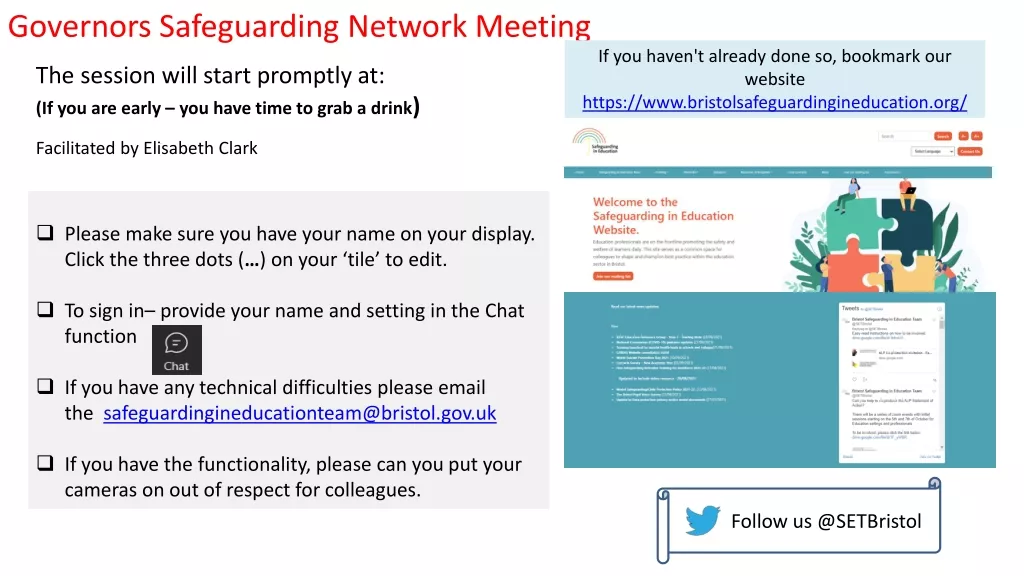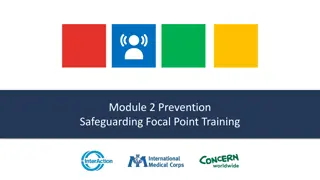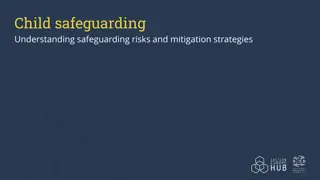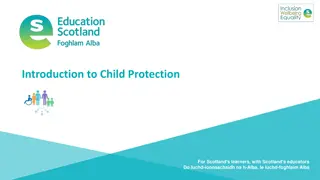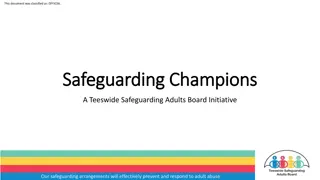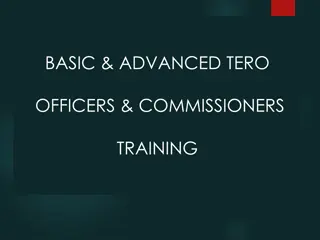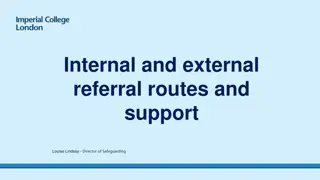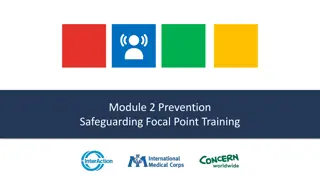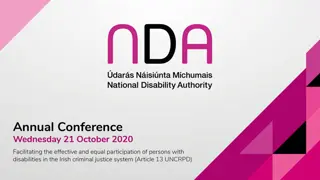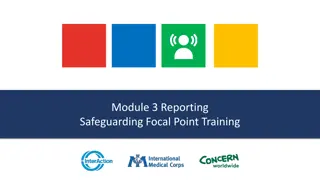Safeguarding Principles and Legislation Overview
The principles, legislation, guidance, and procedures supporting safeguarding in Wales are outlined, emphasizing the importance of individual voice and control, early intervention, well-being promotion, and multi-agency collaboration. The Social Services and Well-being (Wales) Act 2014 plays a central role in safeguarding, focusing on information, advice, and assistance services to prevent issues from escalating. Key values in safeguarding practice, such as shared responsibility and a child-centered approach, underscore the significance of co-producing solutions and prioritizing the well-being of individuals at risk.
Download Presentation

Please find below an Image/Link to download the presentation.
The content on the website is provided AS IS for your information and personal use only. It may not be sold, licensed, or shared on other websites without obtaining consent from the author.If you encounter any issues during the download, it is possible that the publisher has removed the file from their server.
You are allowed to download the files provided on this website for personal or commercial use, subject to the condition that they are used lawfully. All files are the property of their respective owners.
The content on the website is provided AS IS for your information and personal use only. It may not be sold, licensed, or shared on other websites without obtaining consent from the author.
E N D
Presentation Transcript
Safeguarding principles The principles supporting legislation, guidance and the Wales Safeguarding Procedures
Social Services and Well-being (Wales) Act 2014 Voice and control of the individual Prevention and early intervention to prevent escalation of issues Well-being of the individual, to be promoted by all persons delivering functions under the Act Co-production between individual and agencies, across agencies and sectors, co-producing services and solutions Multi-agency in this case, safeguarding is everybody s business Principles of the Act apply across all parts, including part 7 safeguarding
Information, advice and assistance Local authorities, under the code of practice,have a duty to establish an information, advice and assistance service (IAA) to: proactively promote early intervention and prevention emphasise advocacy and co-production provide the public with information and advice to prevent escalation of difficulties to situations that require more intensive, specialist intervention
Information, advice and assistance Information is quality data that helps a person make an informed choice about their well-being Advice means working co-productively with a person to explore options, ensure they understand what is available to them, and actively involve them in making decisions about what matters to them and the personal outcomes they wish to achieve Assistance involves taking action with the person to access care and support, or a carer to access support
Key values Two key values in safeguarding practice: 1) safeguarding is everybody s responsibility 2) a child-centred approach
Value: Safeguarding iseverybodys responsibility Each practitioner and organisation must: contribute to safeguarding and promoting the well-being of the child share information following data protection guidelines work with practitioners within your team and other agencies to better understand the child, their circumstances and their needs develop co-productive working relationships with the child at risk, their family and carers to establish what matters to them and to ensure they feel respected and informed
Six safeguarding principles Principle 1 Put the wishes, needs and well-being of the child first, so they receive the care and support they need before a problem escalates Principle 2 All practitioners who come into contact with children are alert to their needs, including any potential or suspected abuse or risk of abuse or harm, and understand what action they should take
Six safeguarding principles Principle 3 All practitioners share appropriate information and have direct access to advice to discuss any concerns about a child Principle 4 All practitioners are able to use their professional judgment to put the child s needs and personal outcomes at the centre of the system so that the right solution can be found for them
Six safeguarding principles Principle 5 All practitioners working with a child operate in a multi- agency and co-operative way to safeguard and promote a child s well-being, record decisions appropriately and regularly review progress against the outcomes set out in care and support plans Principle 6 All practitioners who come into contact with children are able to access professional strategic leadership which supports the practitioner to achieve desired outcomes for the child
All practitioners should: understand their safeguarding role and responsibilities follow their organisation s safeguarding procedures and protocols understand their duty to report/act be alert to indicators of abuse and neglect to the child have received training appropriate to their role and responsibilities understand the safeguarding process contribute as necessary at all stages of the safeguarding process
Safeguarding tasks The practitioner has two tasks: 1) to prevent situations where a child may experience abuse, neglect and harm and if this is not effective 2) to identify emerging concerns about abuse, neglect and harm to the child
Identifying emerging concerns What are my concernsabout the child s well-being that, if not addressed, could cause significant harm? What is the evidence to support these concerns? Is parenting capacity, family or environment factors an issue?
Addressing emerging concerns You can provide early interventions through: assistance general and/or specific advice information Interventions should involve: holistic approach supporting/working with the family as equal partners innovative solutions a diverse range of services flexibility shared ownership and active contributions by all practitioners
Developing early interventions When developing interventions, you should take a whole family approach to improving outcomes and adapt to individual family circumstances You should: empower families to take control of their lives integrate different ways of working with the family maintain focus on the needs of the child address issues in the local community that may affect parent(s)/carer s ability to meet the child s needs seek opportunities to link with other local programmes be proactive and put support in place as soon as you identify any needs in the family
Key partners might include: education / schools midwifery services / health visitors / other health agencies housing services family information services (FIS) police third sector and community services organisations providing specialist services


